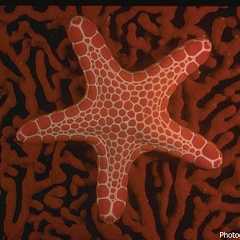| There
are at least 800 species of echinoderm
on the Great Barrier Reef, including
many that are rare. Types of echinoderms
include sea stars, sea cucumbers, sea
urchins and crinoids.
Echinoderms
are among the strangest of invertebrate
animals. They have no real head or
tail end. Instead their bodies are
built on a radial pattern, often in
a form with five sides. They have
three main characteristics including
a symmetrical five-part body plan,
tube feet and a skeleton of plates.
All echinoderms are marine animals.
Their amazing water-vascular system,
consisting of water-filled tubes ending
in numerous finger-like projections
(tube feet) that stick out through
the skin, is their most interesting
feature.
Tube
feet, on the end of the suckers are
used for movement. The water-vascular
system works on water pressure, creating
a network of tube feet that look like
hundreds of tiny, hydraulically operated
legs. The name echinoderm, meaning
spiny skin, relates to their outer
surface that is covered with limestone
plates that are often formed into
spines. The variations of shapes range
from sausage and star shapes to a
ball of spikes.
Echinoderms
occupy all habitats including coral
reefs, mangroves, seagrass and soft-bottom
areas. Many echinoderms are able to
undergo asexual reproduction when
parts of their bodies break off and
grow. Sexual reproduction involves
mass spawning. Echinoderms exhibit
a wide range of feeding techniques
including suspension feeders, deposit
feeders, carnivores, browsers and
parasites. Some species use modified
arms to filter food from the water.
Others, like sea urchins, use their
tooth-bearing jaw structure known
as 'Aristotle's lantern' to scrape
algae from rocks.
|

Seastar
from our southern waters.
Courtesy Parks
Victoria
Interesting
Fact
Frightened sea cucumbers can expel
their entire stomach through their
posterior to distract predators.
The sea cucumbers' intestines
re-grow after about 9 days. |
|
